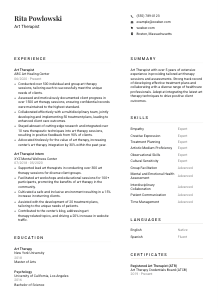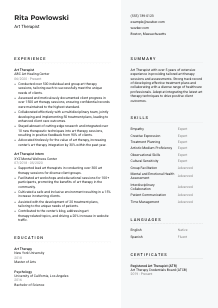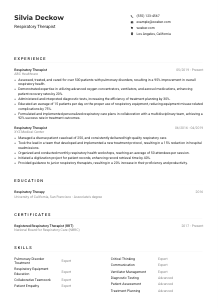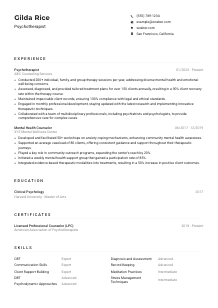Art Therapist Resume Example
Healing through art, but your resume feels a bit abstract? Dive into this Art Therapist resume example, painted with Wozber free resume builder. Discover how to blend your creative palette with job needs, sculpting a career canvas that truly resonates with employers' hearts.
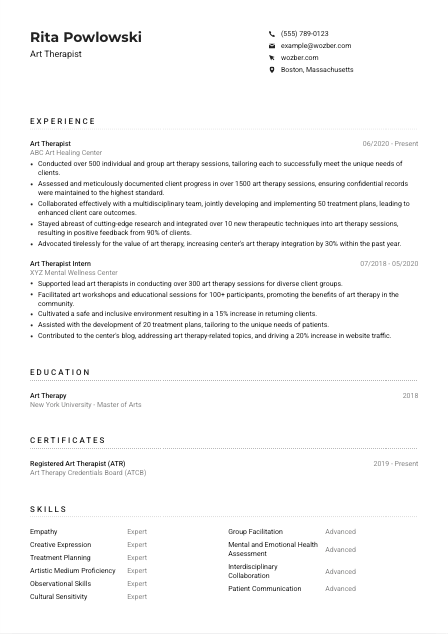
How to write an Art Therapist Resume?
Hello, aspiring Art Therapist! Landing your dream role isn't just about holding the brush; it's about painting your abilities on the canvas of your resume with such skill that hiring managers can't help but take notice. With the Wozber free resume builder, we're here to guide you through creating a resume that not only speaks volumes about your expertise but also sings harmoniously with the role you're eyeing. Let's embark on this creative journey, blending your professional palette with the specific demands of an Art Therapist position.
Personal Details
The Personal Details section is where you lay down the first colors of your professional portrait. It's not merely about listing your contact information; it's about aligning those details with the essence of an Art Therapist's role. Let's finesse this section to ensure it provides the perfect introduction.
1. Brand Yourself with Your Name
Imagine your name as the title of your masterpiece. It's the first thing people will notice, so make it prominent using a clear, readable font. This simple touch sets the tone for the rest of your resume.
2. Paint with the Role In Mind
Just below your name, proudly showcase the position you're aspiring for - "Art Therapist". This tells the hiring manager at first glance that your resume is a meticulously tailored masterpiece.
3. Contact Details: Where to Find You
Ensure your contact information is both precise and professional. Consider a format like firstname.lastname@email.com for your email. A mistake here is like an unintended brushstroke on a nearly complete canvas.
4. Location: Setting the Scene
Given the job specifies "Must be located in Boston, Massachusetts", your contact section should affirm this requirement. There's no need for a complete address; the city and state will suffice. It's like selecting the right backdrop for your art therapy sessions.
5. A Professional Link, Perhaps?
Adding a LinkedIn profile can help further color in your professional picture, as long as it mirrors your resume. This additional detail can offer a fuller picture of your professional landscape.
Takeaway
Consider the Personal Details section the opening act of your professional showcase. It's where you want to intrigue and assure the hiring manager that they're about to dive into the story of a dedicated Art Therapist. Let's ensure this introduction sets the stage for the narrative to unfold effectively.





Experience
The Experience section is where the depth of your professional journey comes to life, illustrating your ability to fulfill the Art Therapist role. It's vital to portray not just where you've been, but how those experiences have sculpted you into the ideal candidate.
- Conducted over 500 individual and group art therapy sessions, tailoring each to successfully meet the unique needs of clients.
- Assessed and meticulously documented client progress in over 1500 art therapy sessions, ensuring confidential records were maintained to the highest standard.
- Collaborated effectively with a multidisciplinary team, jointly developing and implementing 50 treatment plans, leading to enhanced client care outcomes.
- Stayed abreast of cutting‑edge research and integrated over 10 new therapeutic techniques into art therapy sessions, resulting in positive feedback from 90% of clients.
- Advocated tirelessly for the value of art therapy, increasing center's art therapy integration by 30% within the past year.
- Supported lead art therapists in conducting over 300 art therapy sessions for diverse client groups.
- Facilitated art workshops and educational sessions for 100+ participants, promoting the benefits of art therapy in the community.
- Cultivated a safe and inclusive environment resulting in a 15% increase in returning clients.
- Assisted with the development of 20 treatment plans, tailoring to the unique needs of patients.
- Contributed to the center's blog, addressing art therapy‑related topics, and driving a 20% increase in website traffic.
1. Sketching Out the Job Description
Your first task is like preparing your palette: break down the job description, identifying key responsibilities and required experiences. This prep work ensures that every detail you add to your resume aligns with what the hiring manager is seeking.
2. Presenting Your Artistic Journey
List your experiences in reverse chronological order, highlighting roles most relevant to art therapy. For each position, include your title, the name of the organization, and your tenure there. It's like showing a progression in your artwork, where each piece leads to your current mastery.
3. Depicting Achievements
For each role, craft accomplishment statements that reflect the job's demands. If you've "Conducted over 500 individual and group art therapy sessions", it showcases your deep engagement and capability, resonating directly with the job's requirements.
4. The Power of Quantification
Quantifiable achievements can transform your resume. They provide a clear, tangible measure of your impact. For instance, noting a "30% increase in art therapy integration" speaks volumes about your influence in your role.
5. Focusing on Relevant Strokes
Keep the content relevant to the Art Therapist role. While it might be tempting to include every detail of your professional journey, prioritize experiences that align with art therapy, ensuring every point is a deliberate stroke on your canvas.
Takeaway
Your experience section is not just a list; it's a narrative of your professional journey as an Art Therapist. Tailor each point to reflect how your experiences equip you for the role, demonstrating your readiness to make a significant impact. Let your career canvas shine!
Education
In art therapy, your educational background is not just a requirement; it's the foundation upon which your practice is built. Let's ensure your Education section reflects the depth and relevance of your academic achievements, particularly highlighting your qualifications to be an exemplary Art Therapist.
1. Identifying Key Educational Elements
The role specifies a "Master's degree in Art Therapy, Counseling Psychology, or a related field." Your education section must directly reflect this requirement, clearly showcasing your highest level of relevant academic achievement.
2. Structuring with Clarity
Maintain a neat structure, listing your degrees in reverse chronological order. This format allows the hiring manager to quickly ascertain that your academic journey aligns with the prerequisites of an Art Therapist.
3. Matching Degree Specifics
Given the specific demand for a Master's degree in fields related to Art Therapy, ensure your listed degrees directly correspond. If your qualification exactly matches the job's requirements, it's like having the right colors to paint your professional picture.
4. The Brush Strokes of Relevant Courses
In situations where your degree is particularly aligned with the role, mentioning relevant coursework can add depth to your educational portrait. While not always necessary, it can be particularly useful early in your career.
5. Adding Accents with Achievements
Should you have any educational achievements like honors, related extracurricular activities, or significant projects, including them can add further dimensions to your profile, provided they are relevant and not too distant in your past.
Takeaway
Your Education section is a testament to the formal training that has shaped you as an Art Therapist. It lays the groundwork, showing the hiring manager that you possess the essential knowledge and skills. Paint this section carefully, ensuring it aligns perfectly with your professional narrative.
Certificates
Certificates can be like specialized colors on your palette, offering nuances that further illustrate your qualifications and ongoing commitment to growth. Especially in a field as specialized as Art Therapy, certifiably enhancing your skillset can be incredibly compelling.
1. Highlighting Pertinent Certifications
Reflect on the job requirements, identifying any specifically mentioned certifications. The mention of "Certification as a Registered Art Therapist (ATR)" is non-negotiable, and listing it shows you meet the critical credential criteria.
2. Choosing Relevant Enhancements
While the necessity of including the ATR certification is clear, any additional relevant certificates should also be listed. Prioritize those that strengthen your candidacy for an Art Therapist role, ensuring each one contributes meaningfully to your professional story.
3. Being Clear About Dates
For certifications like the ATR, where currency is essential, ensure to list acquisition or expiration dates, providing clarity on your certification's validity. It's like assuring the integrity of the materials in your professional toolkit.
4. Keeping Your Palette Fresh
The field of art therapy, like any form of therapy, is ever-evolving. Stay abreast of developments and continually seek new certifications that demonstrate your commitment to professional growth and excellence in practice.
Takeaway
Certificates augment your resume by showcasing your commitment to professional development and mastery of specialized skills. In the intricate field of Art Therapy, they can be the defining shades that set you apart from other candidates. Let them underscore your expertise and readiness to contribute.
Skills
In the art and science of therapy, your skills are the techniques that allow you to create meaningful change. The Skills section of your resume should reflect a blend of empathy, creativity, and technical competence, resonating deeply with the responsibilities of an Art Therapist.
1. Extracting the Essence
Analyze the job description to identify both the explicit skills required and the implicit ones hinted at. Skills like "Exceptional empathy" and "Proficiency in various artistic mediums" aren't just text; they're the core of what makes an exceptional Art Therapist.
2. Painting a Picture of Your Abilities
Carefully select the skills that showcase your qualifications for the job. Keep the list focused and relevant - each skill you include is a stroke of paint on the canvas, contributing to the overall picture of your capabilities.
3. Harmony in Presentation
Avoid cluttering the canvas. While it might be tempting to list every skill under the sun, curate your list to include those that best speak to your abilities as an Art Therapist. This section is about quality over quantity, showing the hiring manager you possess the right mix of skills for the role.
Takeaway
The Skills section is your chance to display the array of professional techniques you bring to the therapy room. Tailor this section to reflect the job's requirements, emphasizing how your unique skillset makes you the ideal candidate for the position. Remember, this is where your professional abilities shine brightest.
Languages
In a role that hinges on communication, your ability to articulate and understand nuances across languages can be a powerful tool. While the Art Therapist role specifies "Proficiency in English," the inclusion of additional languages can illustrate your capacity to reach a broader audience.
1. Ensuring Core Competencies
First and foremost, confirm your proficiency in the explicitly required language - English, in this case. Detailing your native or fluent proficiency establishes that you possess the foundational communication skills for the role.
2. Accentuating Additional Linguistic Abilities
If you have proficiency in other languages, listing them can add an extra layer of appeal to your resume. Each language you speak is like a different brush you can use to connect with clients from diverse backgrounds.
3. Clarity on Proficiency
Be transparent about your level of fluency in each language, using terms like 'native,' 'fluent,' 'intermediate,' or 'basic.' This provides the hiring manager with a clear picture of your communication capabilities.
4. The Potential for Global Reach
For a role that could involve diverse clientele, your multilingual abilities signify your readiness to engage with clients across different cultural backgrounds. It's an indication of cultural sensitivity, an invaluable trait in the therapeutic setting.
5. Viewing Languages as Tools
Consider each language you know as a unique tool in your professional toolkit. In the realm of art therapy, where expressions transcend words, the ability to communicate in multiple languages can significantly enhance your practice.
Takeaway
Your fluency in various languages speaks volumes about your ability to connect and empathize with clients from diverse backgrounds. Highlighting these abilities on your resume can set you apart, showcasing you as an Art Therapist capable of making a profound impact on a global scale.
Summary
A compelling Summary section is like the focal point of your artwork; it draws the viewer in, inviting them to explore further. Crafting a summary that encapsulates your qualifications and passion for art therapy can make a powerful opening statement.
1. Comprehending the Job's Core
Immerse yourself in the job description, absorbing the essence of what's required for the role. This understanding allows you to sculpt a summary that resonates with the demands of an Art Therapist position.
2. Sketching Your Professional Identity
Begin with a bold stroke: introduce yourself and outline your journey. Mention your years of experience and areas of expertise, like having "over 5 years of extensive experience in providing tailored art therapy sessions." This sets the tone for your narrative.
3. Highlighting Your Palette of Skills
Paint a vivid picture of your professional traits and accomplishments. Highlight the skills and experiences that directly address the job requirements, demonstrating the unique impact you have made in your field.
4. Framing with Focus
Your Summary should be a tightly framed composition, offering just enough detail to captivate interest while enticing the hiring manager to delve deeper into your resume. Think of it as creating an invitation to explore your professional gallery.
Takeaway
The Summary is your chance to make an impactful first impression. It signals to the hiring manager that you're not only qualified but deeply connected to the role of an Art Therapist. Craft this section with care, letting it reflect the passion and dedication that define your career. Your professional narrative starts here; make it inspiring.
Embarking on Your Art Therapist Career Journey
Congratulations on navigating the nuanced process of crafting your Art Therapist resume. With these insights, you possess the tools to create a resume that not only meets the job specifications but vividly portrays your unique qualifications and passion for art therapy. Your resume is more than a document; it's the canvas where you showcase your professional journey. Use the Wozber free resume builder to ensure your resume is ATS-compliant, leveraging our ATS-friendly resume templates and ATS resume scanner for optimization.
Let it be the key that unlocks doors to new opportunities. Your next chapter awaits; go forth and share your healing art with the world.

- Master's degree in Art Therapy, Counseling Psychology, or a related field.
- Certification as a Registered Art Therapist (ATR) from the Art Therapy Credentials Board (ATCB).
- Minimum of 3 years of clinical experience in art therapy practice.
- Proficiency in various artistic mediums and therapeutic techniques.
- Exceptional empathy, active listening, and observational skills.
- Proficiency in English is a critical component of this role.
- Must be located in Boston, Massachusetts.
- Conduct individual and group art therapy sessions, tailored to meet the needs of each client.
- Assess and document client progress in art therapy, maintaining confidential records.
- Collaborate with interdisciplinary teams to develop and implement treatment plans.
- Stay updated on the latest research and best practices in art therapy, incorporating new techniques into sessions when appropriate.
- Advocate for the value of art therapy and its integration into client care.





